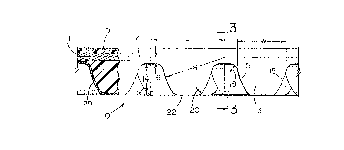Some of the information on this Web page has been provided by external sources. The Government of Canada is not responsible for the accuracy, reliability or currency of the information supplied by external sources. Users wishing to rely upon this information should consult directly with the source of the information. Content provided by external sources is not subject to official languages, privacy and accessibility requirements.
Any discrepancies in the text and image of the Claims and Abstract are due to differing posting times. Text of the Claims and Abstract are posted:
| (12) Patent: | (11) CA 2075863 |
|---|---|
| (54) English Title: | SYNCHRONOUS DRIVE BELT WITH OBLIQUE AND OFFSET TEETH |
| (54) French Title: | COURROIE D'ENTRAINEMENT SYNCHRONE A DENTS OBLIQUES ET DECALEES |
| Status: | Term Expired - Post Grant Beyond Limit |
| (51) International Patent Classification (IPC): |
|
|---|---|
| (72) Inventors : |
|
| (73) Owners : |
|
| (71) Applicants : | |
| (74) Agent: | MARKS & CLERK |
| (74) Associate agent: | |
| (45) Issued: | 1998-09-15 |
| (22) Filed Date: | 1992-08-12 |
| (41) Open to Public Inspection: | 1993-11-30 |
| Examination requested: | 1993-07-12 |
| Availability of licence: | N/A |
| Dedicated to the Public: | N/A |
| (25) Language of filing: | English |
| Patent Cooperation Treaty (PCT): | No |
|---|
| (30) Application Priority Data: | ||||||
|---|---|---|---|---|---|---|
|
A synchronous drive belt has at least two
adjacent rows of teeth which are at oppositely
balanced oblique angles to the longitudinal direction
of the belt. In addition, the centerlines of the
teeth in the adjacent rows are offset from each other
by a distance of up to 10% to 90% of their pitch.
Courroie d'entraînement synchrone présentant au moins deux rangées adjacentes de dents qui sont disposées à angles obliques équilibrés opposés au sens longitudinal de la courroie. De plus, les axes centraux des dents des rangées adjacentes sont décalés les uns par rapport aux autres d'une distance allant de 10 à 90 % de leur inclinaison.
Note: Claims are shown in the official language in which they were submitted.
Note: Descriptions are shown in the official language in which they were submitted.

2024-08-01:As part of the Next Generation Patents (NGP) transition, the Canadian Patents Database (CPD) now contains a more detailed Event History, which replicates the Event Log of our new back-office solution.
Please note that "Inactive:" events refers to events no longer in use in our new back-office solution.
For a clearer understanding of the status of the application/patent presented on this page, the site Disclaimer , as well as the definitions for Patent , Event History , Maintenance Fee and Payment History should be consulted.
| Description | Date |
|---|---|
| Inactive: Expired (new Act pat) | 2012-08-12 |
| Letter Sent | 2009-06-26 |
| Inactive: IPC from MCD | 2006-03-11 |
| Grant by Issuance | 1998-09-15 |
| Inactive: Final fee received | 1998-05-11 |
| Pre-grant | 1998-05-11 |
| Notice of Allowance is Issued | 1997-11-19 |
| Notice of Allowance is Issued | 1997-11-19 |
| Letter Sent | 1997-11-19 |
| Inactive: Application prosecuted on TS as of Log entry date | 1997-11-13 |
| Inactive: Status info is complete as of Log entry date | 1997-11-13 |
| Inactive: First IPC assigned | 1997-11-05 |
| Inactive: IPC removed | 1997-11-05 |
| Inactive: IPC assigned | 1997-11-05 |
| Inactive: Approved for allowance (AFA) | 1997-11-05 |
| Application Published (Open to Public Inspection) | 1993-11-30 |
| All Requirements for Examination Determined Compliant | 1993-07-12 |
| Request for Examination Requirements Determined Compliant | 1993-07-12 |
There is no abandonment history.
The last payment was received on
Note : If the full payment has not been received on or before the date indicated, a further fee may be required which may be one of the following
Please refer to the CIPO Patent Fees web page to see all current fee amounts.
Note: Records showing the ownership history in alphabetical order.
| Current Owners on Record |
|---|
| VEYANCE TECHNOLOGIES, INC. |
| Past Owners on Record |
|---|
| MICHAEL J. W. GREGG |